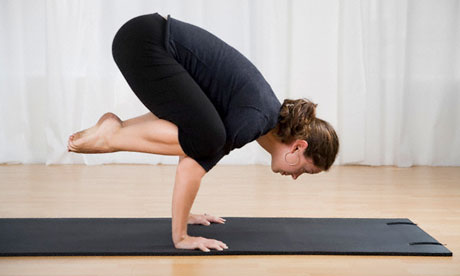
Yoga, once the pastime of contemplative types, now comes in more varieties than ice-cream. All yoga has postures, relaxation and controlled breathing as core ingredients. But some schools emphasise power and strength and can include exercises that verge on the unnatural. Headstands, which you tell your children not to do, are a favourite of some yoga devotees, as are shoulder stands (not good for all the major nerve junction in your armpit) and squats that can put huge pressure on your knees.
But when William J Broad wrote an article in the New York Times two weeks ago called "How yoga can wreck your body" he was attacked by practitioners. Yoga is now so popular, he argued, and used to get fit as much as for relaxation, that it's no wonder it is causing injuries. So should you try something less dangerous or can you minimise the risks?
The solution
The main risks involve putting your body into extreme positions. Broad cited examples of yoga positions causing strokes by over-extending the neck and compressing the basilar artery, which supplies blood to the brain. These positions also caused headaches, dizziness and loss of balance. Often, Broad said, people didn't associate their problems with yoga.
Some of the most common yoga poses, if done repeatedly and over-enthusiastically may be harmful. The chair pose in which you squat with your knees bent and back straight is meant to straighten your legs but can put pressure on your knees, especially the anterior cruciate ligament which once over-stretched is rarely the same again. The downward-facing dog pose in which you put hands and feet on the floor and form an inverted V has been credited with tearing the achilles tendon at the heel and over-extending wrists.
The idea that yoga could harm as well as heal is not new. In 1971 the Journal of the American Medical Association published a report of a man who had sat in a pose that involved kneeling and sitting on his heels (for hours a day in his case) and damaged a branch of his sciatic nerve running down the back of his leg. This caused what became known as yoga foot drop. He couldn't walk because his feet had become weak but after stopping he recovered quickly.
Yoga is credited with improving heart and lung function in older people, reducing blood pressure and doing as much to relieve back pain as to cause it. It may reduce anxiety and probably does help with obsessive-compulsive disorder. But the evidence for the benefits of yoga is plagued by small studies using different methodologies.
It is essential to practise under the guidance of an experienced and reputable teacher. If you get pins and needles or anything goes numb, stop. Be reflective rather than competitive; do not over-extend anything, ever.

